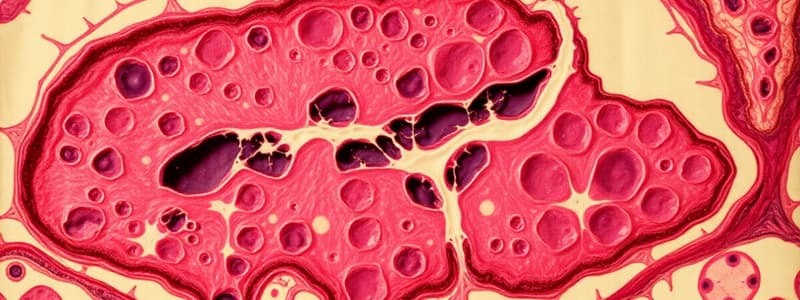Podcast
Questions and Answers
Which of the following types of tissue is responsible for covering and protecting the body?
Which of the following types of tissue is responsible for covering and protecting the body?
- Connective tissue
- Epithelial tissue (correct)
- Nervous tissue
- Muscular tissue
Connective tissue primarily generates body heat.
Connective tissue primarily generates body heat.
False (B)
What is the scientific study of tissues called?
What is the scientific study of tissues called?
Histology
Muscular tissue is made of specialized cells that ________ to generate force.
Muscular tissue is made of specialized cells that ________ to generate force.
Which type of cell junction forms leakproof connections?
Which type of cell junction forms leakproof connections?
Desmosomes are responsible for connecting cells and preventing tearing during stretching.
Desmosomes are responsible for connecting cells and preventing tearing during stretching.
Hemidesmosomes connect cells to the underlying ________ membrane.
Hemidesmosomes connect cells to the underlying ________ membrane.
Match each tissue type with its primary function:
Match each tissue type with its primary function:
Flashcards are hidden until you start studying
Study Notes
Tissue Overview
- A tissue consists of a group of cells originating from a common progenitor cell, performing a coordinated function.
- Four primary types of tissues in the human body: Epithelial, Connective, Muscular, and Nervous.
- Histology is the scientific study of tissues.
Functions of Human Tissues
- Epithelial Tissue
- Covers and protects body surfaces; lines hollow organs.
- Forms glands.
- Specializes in material exchange with both internal and external environments.
- Connective Tissue
- Protects and supports the body and internal organs.
- Connects different organs and stores energy.
- Plays a role in immunity.
- Muscular Tissue
- Composed of cells that contract to generate force.
- Important for heat production in the body.
- Nervous Tissue
- Responsible for detecting stimuli and generating responses.
- Produces electrical signals known as nerve impulses, influencing muscle and gland activity.
Cell Junctions
- Cells in tissues are joined by cell junctions, which are contact points between adjacent cells.
- Five main types of cell junctions: Tight junctions, Adherens junctions, Desmosomes, Hemidesmosomes, and Gap junctions.
Tight Junctions
- Form leakproof connections between cells.
- Mediated by transmembrane proteins.
- Examples include the stomach lining, intestinal epithelium, and urinary bladder lining.
Adherens Junctions
- Connect adjacent cells through transmembrane proteins and cytoplasmic proteins called plaques.
- The plaque links transmembrane proteins to microfilaments (actin).
- Effective in resisting pulling forces, such as during muscle contraction.
Desmosomes
- Connect adjacent cells, offering resistance to contraction.
- Structure is similar to adherens junctions but links transmembrane proteins to intermediate filaments.
- Prevents tearing of the epidermis during stretching and protects muscle cells in the heart.
Hemidesmosomes
- Anchor cells to underlying tissues, connecting them to the basement membrane.
- Utilize transmembrane glycoproteins that bind intermediate filaments to basement membrane proteins, known as laminins.
- Help resist abrasion, anchoring skin to its underlying connective tissue.
Studying That Suits You
Use AI to generate personalized quizzes and flashcards to suit your learning preferences.




